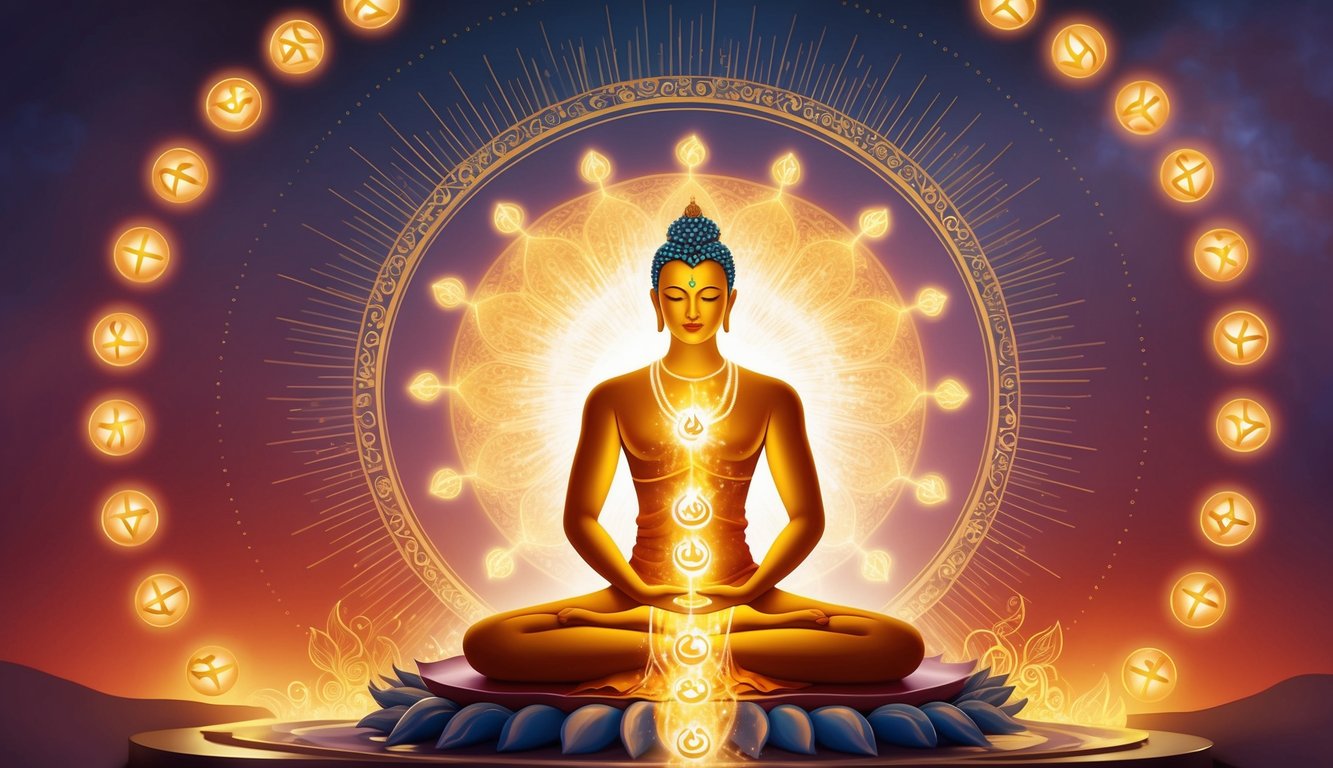Don’t Miss Out On This Unique Astrological Opportunity
Are you tired of spinning your wheels and getting nowhere? Simply put, you’re out of sync: you’re out of alignment with your astral configuration.
But: there’s a kind of map that can help you reclaim your alignment. Think of it as your own personal blueprint to success and happiness: a blueprint that will help you live your most amazing life.
Get started here.
The idea of being “made in the image of God” is a profound concept that has intrigued theologians and philosophers alike.
It suggests a special connection between humans and the divine, where humanity reflects certain characteristics of God.
This notion impacts how you view human nature and the inherent dignity of every person.
Theological discussions often explore what it means to bear this image and how it influences ethical decision-making and relationships with others.
From a Christian perspective, some believe that the image of God also hints at the potential for spiritual growth and renewal.
The concept of restoration is often discussed in connection with how Jesus Christ plays a role in returning humanity to its original divine likeness.
Understanding these ideas gives deeper insights into human identity and purpose.
By exploring how this image influences your life and interactions with others, you can appreciate its relevance in today’s world.
Key Takeaways
- You are made in the image of God, reflecting divine characteristics.
- The concept influences ethical views and how you perceive human dignity.
- Jesus Christ is seen as central to restoring the divine image in humankind.
The Concept of ‘Image of God’ in Theology
The biblical concept of humans being created “in the image of God” is central to understanding our identity and purpose.
Key texts, especially from Genesis, and various theological interpretations have explored what it means to reflect God’s likeness.
Biblical Foundations: Genesis and Imago Dei
In Genesis 1:27, the phrase “God created man in his own image” is pivotal.
This asserts that humans hold a unique position among creatures.
It suggests a direct relationship between humanity and the divine, emphasizing our dignity and value.
Being made in God’s likeness implies that humans possess qualities reflecting the Creator, such as rationality, intellect, and conscience.
These attributes contribute to the spirit and soul of every person.
Furthermore, the concept of “Imago Dei” underscores the moral and ethical responsibilities of humans.
We are called to mirror the glory and holiness of God in our daily lives.
Theological Interpretations of ‘Image of God’
Theological discussions around the “image of God” explore different dimensions.
Historically, scholars have debated whether the image refers to the physical or spiritual aspects of humans.
Some argue it points to the intellect and ability for moral reasoning, setting humans apart from other living creatures.
This idea also extends to the concept of transformation into a “new self,” where believers strive to embody divine qualities.
An example is Genesis 9:6, which links the image of God to the sanctity of life.
Additionally, it is important to understand the role of the fall in affecting but not erasing this divine image, leaving humans with the task of restoring that likeness through spiritual and moral growth.
Human Nature and Divine Likeness

In exploring the idea of being made in the image of God, consider how it relates to human nature and divine likeness.
This involves examining how attributes like rationality, will, and moral responsibility reflect this image, as well as how both genders express it.
Rationality, Will, and Moral Responsibility
You can understand the divine likeness through the concepts of rationality and will.
These traits allow humans to reflect God’s image by making choices and understanding complex issues.
The intellect gives humans the ability to reason, which underpins moral and ethical decision-making.
Your conscience plays a crucial role in this, as it helps guide actions according to moral laws.
This aspect of human nature connects closely to moral responsibility, emphasizing that you are accountable for your actions.
Having dominion over nature is another responsibility that showcases divine likeness.
It highlights the balance between exercising control and caring for the world.
By acting responsibly, you fulfill a vital role in stewardship, demonstrating aspects of the divine image embedded within.
The Image of God in Gender: Male and Female
The idea of being made in the image of God applies to both male and female, as seen in the first humans, Adam and Eve.
This reflects a shared nature in expressing divine characteristics.
Male and female attributes are meant to complement each other, each contributing unique strengths and perspectives.
Understanding gender roles strengthens the notion of unity in diversity.
By valuing the contributions of both genders, you acknowledge the complexity and balance present in the divine image.
The differences in male and female perspectives highlight varied aspects of God’s nature, enabling a fuller reflection of the divine likeness when they work together.
This inclusive view enforces the idea that both genders equally bear the image of God, enriching the human experience.
Implications for Human Dignity and Ethics
The concept of being “made in the image of God” carries significant implications for how we perceive human dignity and ethics.
These concepts influence how we approach issues like respect for life and difficult ethical decisions.
Dignity, Respect, and the Sanctity of Life
Understanding human dignity through the lens of being created in God’s image emphasizes the intrinsic value of every individual.
This concept suggests that every person deserves respect and recognition, echoing sentiments found in texts like James 3:9, where humans are said to reflect God’s image.
The idea serves as a mirror, reminding you that human life is sacred and holds immense value.
This perspective encourages you to treat every person with equal compassion and kindness, acknowledging the spiritual and moral foundation from which dignity is derived.
Spirituality and family relationships play a crucial role in shaping these attitudes.
By recognizing everyone’s worth, you foster environments where mercy and love thrive.
Understanding the significance of dignity helps in appreciating the deaf ears in communication and understanding, ensuring that everyone feels valued and respected.
Ethical Considerations: From Abortion to Euthanasia
Ethical dilemmas like abortion and euthanasia challenge your understanding of dignity and respect for human life.
When faced with these issues, it’s essential to balance compassion with moral considerations.
These decisions often involve thinking about the sanctity of life and the ethical implications of taking or ending it.
In discussions about abortion, the idea of life being sacred can influence your stance, making you question choices that might defile or diminish life.
Similarly, debates about euthanasia often revolve around questions of mercy, pain, and whether ending suffering respects or diminishes inherent human value.
An ethical framework rooted in the belief that humans reflect God guides you in navigating these complex moral landscapes.
The Restoration of the Image Through Christ

The restoration of God’s image in humanity is deeply connected to the role and work of Jesus Christ.
Through His sacrifice, believers find renewal and a return to righteousness, bridging the gap caused by sin.
This transformation is further empowered by Acts 2 and the Holy Spirit, who works within believers to shape them into the likeness of Christ.
Through the Spirit’s guidance, they grow in faith, holiness, and obedience, reflecting God’s image more fully.
This ongoing renewal strengthens their relationship with God and equips them to live out His purpose in the world.
Christ: The True Image of the Invisible God
Christ represents the true image of the invisible God.
In Colossians 3:10, believers are encouraged to put on the new self, which is renewed in the knowledge of the Creator.
This transformation aligns with Jesus’ life and teachings.
He embodies the Father’s glory and majesty, offering a path to purity and creative expression.
Jesus’ life reflects God’s love and honor, setting an example for you.
The relationship between Christ and the Father is central.
In His work on earth, Jesus showed how to live a righteous life, free from sin.
The redemptive power of Jesus’ blood purifies hearts, elevating humanity’s purpose.
Following Him, you become more like Christ, imitating His righteousness and creative essence.
The Redemptive Work of Jesus and Human Renewal
The redemptive work of Jesus brings renewal to the human spirit.
Sin separated humanity from God’s glory, but Christ’s sacrifice provides the path to reconciliation.
Through the shedding of His blood, you find purification from sins, aligning your life with the purpose God designed.
The Bible verses emphasize faith as essential to receiving this renewal.
Rain and fields symbolize growth and renewal.
Just as rain nurtures the earth, the gospel nurtures your faith.
By embracing Jesus Christ’s teachings, you grow in righteousness and love, building a renewed relationship with the Father.
This transformative process is vital, offering hope and a chance to reflect God creatively in your life, much like stars and the moon reflect light.
Frequently Asked Questions

You might be curious about the concept of being “made in the image of God,” as it is often discussed in religious texts.
Below, you’ll find answers to common questions about what this means and its implications.
What does it mean to be created in the image and likeness of God?
Being created in the image and likeness of God suggests that humans share certain qualities with the divine.
This includes aspects like moral capacity, spirituality, and the ability to reason.
How does Genesis 1:26 define the image of God in man?
Genesis 1:26 refers to God creating humans in His image, implying that humans possess unique qualities that reflect God’s nature.
This speaks to the inherent dignity and value in every person.
What are the implications of humanity being created in God’s own image?
Being created in God’s image affects how humans relate to each other and the world.
It highlights the responsibility to care for creation and to treat others with respect and love.
In what ways do humans reflect the image of God, according to the Bible?
According to the Bible, humans reflect God’s image through attributes like creativity, the capacity to love, and moral judgment.
These attributes set humans apart from other forms of life.
Can you explain the meaning and significance of being made perfect in the image of God as mentioned in Scripture?
Scripture often uses this phrase to indicate a state of spiritual wholeness and alignment with God’s will.
It emphasizes striving toward moral and ethical ideals that align with divine intentions.
Which Bible verses specifically reference God creating man in His image?
Key verses include Genesis 1:26-27 and Genesis 9:6.
These verses highlight the significance of human life and the inherent dignity bestowed upon humans by their divine Creator.



